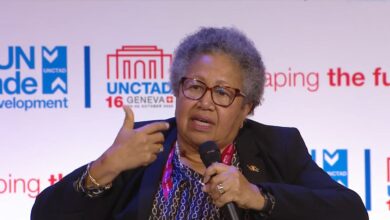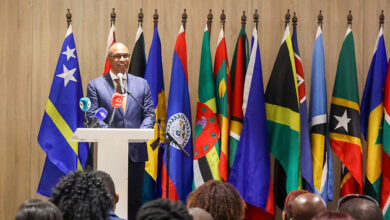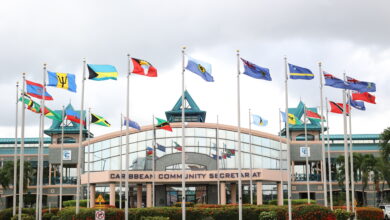For 40 years, Regional integration has been driven by the central aims of improving economic and social wellbeing for all. While the Caribbean Community (CARICOM) can look back with pride at the progress it has made since them, it is time to increase the pace towards greater prosperity
Athe start of the 1970s, in the early days of the Region’s independence from European colonial powers, Commonwealth Caribbean leaders came together and recognised that their countries would be able to achieve greater growth and prosperity by working together. They saw that integration would advance their interests, while discord could only deepen their challenges. The Caribbean Community (CARICOM) can look back with pride at the progress it has made since that time. In addition to national initiatives to improve living standards, education, healthcare provision and investment, CARICOM leaders and businesses have been cooperating to build on their strengths and fuel growth throughout the Region, thanks to the provisions for freer trade, economic integration, cooperation on human and social development and coordinated foreign policy promoted by CARICOM.
When the leaders met at the 7th Heads of Government Conference in 1972, they decided to transform the existing Caribbean Free Trade Association (CARIFTA) into a common market and establish a Caribbean Community. CARIFTA ceased to exist in 1973, paving the way for the signing that year of the Treaty of Chaguaramas, which laid the foundation for free movement of labour and capital and the foreign-policy coordination. CARICOM has since grown to include 15 Member States and five Associate Members.
In 1989, in response to the challenges and opportunities presented by changes in the global economy, Member States reaffirmed the Community’s core objectives and broadened them to include the creation of the CARICOM Single Market and Economy (CSME). The CSME, which set new goals for Regional integration, came into operation in 2006. OF CARICOM’s 15 Member States, 12 are now actively participating in the Single Market.
This transformation required the Treaty to be revised, a project that was taken on by an intergovernmental taskforce set up in 1992. Between 1993 and 2000, the taskforce, which comprised representatives of all Member States, produced nine protocols aimed at amending the Treaty.
These were later combined to create a new version of the Treaty: the Revised Treaty of Chaguaramas Establishing the Caribbean Community, including the CARICOM Single Market and Economy.
The revised Treaty builds on the free movement of goods. It includes provisions on the free movement of people and services, and the right of CARICOM nationals to establish business in any Member State. It also makes provisions for addressing important new issues – such as e-commerce, government procurement, the trade in goods from free zones, the free circulation of goods and the free movement of people –using additional protocols.

Given the importance of free movement in the context of the revised Treaty, efforts have been made to unify travel documents across CARICOM. Antigua and Barbuda, Barbados, Belize, Dominica, Grenada, Guyana, Jamaica, Saint Lucia, St Kitts and Nevis, St Vincent and the Grenadines,
Suriname and Trinidad and Tobago now issue common CARICOM passports that reinforce nationals’ awareness of being members of the Community. Organisation and objectives In accordance with the revised Treaty, CARICOM’s principal organs – the
Conference of Heads of Government and the Community Council of Ministers – are assisted by Councils, Committees and the Secretariat, which is the principle administrative organ. The Councils are:
- Finance and Planning (COFAP), which coordinates economic policy and financial and monetary integration across Member States;
- Trade and Economic Development (COTED), which promotes trade and economic development and oversees the operations of the CSME;
- Foreign and Community Relations (COFCOR), which determines relations to international organisations and Third States; and
- Human and Social Development (COHSOD), which promotes development in areas such as health, education, culture and sport.
In 2007, a fifth Council, National Security and Law Enforcement (CONSLE), was added to coordinate security and law enforcement arrangements across the Community. The Committees are:
- the Legal Affairs Committee, comprising Attorneys-General, which provides legal advice;
- the Budget Committee, which examines the Secretariat’s draft budget and work programme and submits recommendations to the Community Council; and
- the Committee of Central Bank Governors, which provides recommendations to the COFAP on monetary and financial matters.
In 2005, the Caribbean Court of Justice (CCJ) was inaugurated in Trinidad and Tobago, where it is also headquartered. The CCJ’s mission is to “perform to the highest standards as the supreme judicial organ in the Caribbean Community. In its original jurisdiction, it ensures uniform interpretation and application of the Revised Treaty of Chaguaramas, thereby underpinning and advancing the CARICOM Single Market and Economy. As the final court of appeal for Member States of the Caribbean Community, it fosters the development of an indigenous Caribbean jurisprudence.”
Since CARICOM was created, there have been improvements in the standard of living and a consequent rise in life expectancy across Member States. Data from the United Nations Development Programme show that, from 1980 to 2012, life expectancy at birth increased from 67.7 to 75.9 in
The Bahamas, 70.5 to 73.3 in Jamaica, and 65.2 to 76.1 in Grenada. These improvements are the product of concerted efforts to improve healthcare, with current initiatives including the Caribbean Cooperation in Health, now into its third phase (CCH III), which tackles critical issues such as environmental health, communicable and non-communicable diseases, food and nutrition, human and social development and the strengthening of Member States’ health systems. To assist in the implementation of CCH III goals, five Regional Health Institutions were consolidated into the
Caribbean Public Health Agency in July 2013: Caribbean Epidemiology
Centre, Caribbean Health Research Council, Caribbean Environmental
Health Institute, Caribbean Regional Drug Testing Laboratory and
Caribbean Food and Nutrition Institute.
CARICOM is also the driving force behind the Pan Caribbean Partnership Against HIV/AIDS (PANCAP), which was established in 2001. The organisation acts as an advocate for HIV/AIDS issues at governmental levels, coordinates the wider Caribbean region response to the disease, mobilises
Regional and international resources and increases country-level resources.
The PANCAP Coordinating Unit (PCU), which is based at the CARICOM Secretariat in Georgetown, Guyana, is also involved in advocacy and the promotion of information-sharing among PANCAP partners.
The Community has also made progress in early childhood development, child rights and protection, life skills-based health and family-life education. The Region now boasts universal primary education, the expansion of tertiary and higher education and increased capacity-building through
scholarships. The Caribbean Examinations Council (CXC) – which also celebrated its 40th anniversary in 2013, and offers qualifications designed to cater for learners of varying ages, interests and abilities; teacher training; learning support material; and statistical data processing – is a vital link in Regional integration.
Another Regional partnership, the Caribbean Knowledge and Learning Network Agnecy (CKLNA), seeks to devlop a high-speed fibre-optic network linking all Member States in order to improve access to tertiary education across the Region. This will enable collaboration between Member States’ educational institutions and will make tertiary education more affordable and diverse. The CKLNA has worked assiduously to establish the Caribbean Research and Education Network (C@ribNET), launched in February 2013. C@ribNET connects all CARICOM countries and is connected to the world’s research and education community. It also presents opportunities to a wide cross section of the Community’s populace, including in institutions at the tertiary level, in government and in other fields, committed to developing human capital and fostering functional cooperation.
Given the critical role of Information and Communication Technology (ICT) as a factor of development and a key sector in its own right, the Community has adopted a Regional Digital Development Strategy (RDDS) to guide ICT activities and initiatives in the Region.





